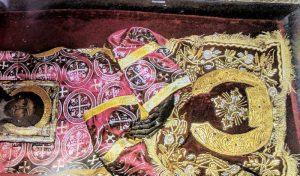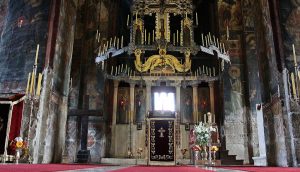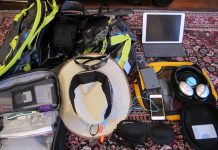The monastery is resplendent with frescoes throughout the interior. They alone make this monastery worth the visit. But the facts that: this monastery still exists despite its location and the troubles in the area; it has remarkable monks who seem truly dedicated; and the interesting backstory make this a “must see” in my book.
The backstory:
The monastery was founded by St. Stefan Uros III of Decani, the son of King Milutin. As a youth, Stefan was accused of attempting to overthrow his father. In response his father had him blinded and imprisoned in Constantinople. Seven years later, he was reconciled with his father who then gave him the region of Budimlje to rule. In 1321, after his father’s death, he was crowned as Uros III. Before his coronation, he removed the bandages from his eyes to reveal the miracle that his eyes had been healed through St. Nicholas the Miracle Worker. He was said to have been a kind King, and he ruled in a manner pleasing to both God and his people. He was very philanthropic and worked toward building and decorating many churches both on his lands and elsewhere. The pinnacle of his efforts was said to be the construction of this Monastery. In his own words “I began to build a house of the Lord God my All-Maintainer, and upon completing it, I decorated it with every beautiful thing inside and without.”
…his body was found to be “intact and fragrant” after being buried for 12 years.
Unfortunately, he died a martyr at the hands of his son’s Lords, after they imprisoned and then executed him in 1331. His body was buried in this Monastery. In 1343 the abbot of the Monastery received a vision of the Martyr who ordered that his body be exhumed. This presented St. Stefan’s second miracle, as his body was found to be “intact and fragrant” after 12 years. His body is now laid in state, and is made available for viewing every Thursday.
My experience:
I was not there on a Thursday, but by luck my visit coincided with a group of devout men who had come to pay homage. Therefore an exception was made and the sarcophagus was opened. One by one, the men climbed the step ladder, viewed the body and bent down to kiss it. They then descended, prostrated themselves on the floor and walked to the head of the sarcophagus where a monk anointed them with holy water. Nothing ventured, nothing gained, eh? I got in line behind the last man and when he descended the ladder, I climbed it. I purposely avoided looking at anyone, in case they would indicate this was not appropriate for me to do. The body was clothed in what appeared to be silk and gold threaded fabric. The head was covered by a fringed, flat drape with fine embroidery work. Laid upon his stomach was a wooden icon of Christ. Only his right hand was exposed, revealing a gold ring.
The miracle:
The concept of Incorruptibility is a Roman Catholic and Eastern Orthodox belief that divine intervention allows some human bodies to avoid the normal process of decomposition after death. This is taken as a sign of their holiness.
Full disclosure: I’m not an expert on ancient, buried bodies. But this hand looked simply desiccated to me. I’ve seen a handful (no pun intended) of bodies around the world that have been thus dried out and preserved, either through drowning in a bog (UK), or by storage in a cold, dry cave (Peru). In fact the website Mental Floss lists 5 such bodies. Whether you believe in the miracle or not is up to you. But even if you don’t, you may still find the history and the story interesting.
![]()
Visit on a Thursday evening if you can. That’s when the body is normally available for viewing.
 Why go?
Why go?
- The monastery is a beautiful old building with amazing frescoes inside. Their color is a little faded, but the detail is remarkable.
- The monks are very accessible and engaging. Much more so than other monasteries I’ve visited.
- Where else can you experience a miracle with your own eyes?
 What you need to know:
What you need to know:
- Viewing of St. Stefan is typically only on Thursday evenings when a special prayer service is held to honor him.
- The body is completely draped by cloth with the exception of his right hand.
- Aside from St. Stefan, the monastery building itself is also quite remarkable with beautiful frescoes.
- This monastery (and the body of St. Stefan) represents part of Serbia’s claim to the land currently occupied by Kosovo, since St. Stefan was one of their kings.
- The monastery is protected by KFOR (under the authority of the UN), with a rotating nationality force. You will need to bring along identification papers (typically your passport) to enter.
- Photography in the monastery is prohibited. The gift shop offers a nice guidebook with color pictures that include the many frescoes and one of St. Stefan’s body.
- St. Stefan’s feast day is November 24th. This date is celebrated each year at the monastery.


From Wikipedia
https://en.wikipedia.org/wiki/File:8._Manastiri_i_De%C3%A7anit.JPG
Copyright AgronBeqiriPh
Visoki Dečani Monastery - Boring picture, but Fascinating Story!
.
Location: Visoki Dečani, Kosovo
.
Stefan Uros, blinded by his own father, not only regained his sight, but his body was found to be "intact and fragrant" 12 years after he was buried. You can still see his "intact" body and witness first-hand one of the miracles which helped to bestow sainthood on him. You`ll have to find your way to my travel blog for pictures and the rest of the story!
.
Head to the link in my profile for more details at my travel blog: @mytravels.hdf
.
Picture taken: 09/2010
.
#visokidecani #visokidečani #decani #dečani #visokidecanimonastery #kosovo #kosova #unesco #unescowo










